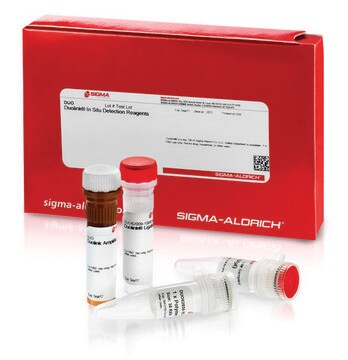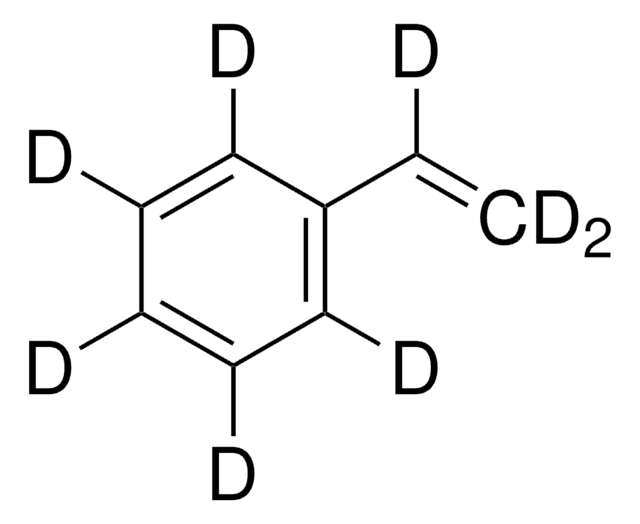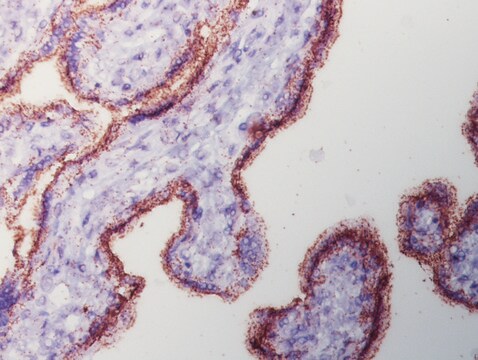DUO92104
Duolink® In Situ Orange Starter Kit Mouse/Goat
Sinonimo/i:
in situ Proximity Ligation Assay reagent, Protein Protein Interaction Kit
About This Item
Prodotti consigliati
Nome Commerciale
Duolink®
Livello qualitativo
tecniche
proximity ligation assay: suitable
Fluorescenza
λex 554 nm; λem 576 nm (orange) (Cyanine 3; Zeiss Filter set 20)
Compatibilità
suitable for fluorescence
Applicazioni
Follow the Duolink® In Situ Fluorescence Protocol to use this product. A set of short instructionsis also available.
Visit our Duolink® PLA Resource Center for information on how to run a Duolink® experiment, applications, troubleshooting, and more.
To perform a complete Duolink® PLA in situ experiment you will need two primary antibodies (PLA, IHC, ICC or IF validated) that recognize two target epitopes. This starter kit supplies all other necessary reagents for 30 Duolink® PLA reactions, which include a pair of PLA probes (Anti-Mouse PLUS and Anti-Goat MINUS), orange detection reagents, wash buffers, and mounting medium.Note that the primary antibodies must come from the same species as the Duolink® PLA probes. Analysis is carried out using standard immunofluorescence assay equipment.
The Duolink® In Situ Orange Starter Kit Mouse/Goat requires one primary antibody from mouse and one primary antibody from goat. Orange fluorescence detection reagents are often used with Cyanine 3 filter.
Application Note
Two primary antibodies raised in different species are needed. Test your primary antibodies (IgG-class, mono- or polyclonal) in a standard immunofluorescence (IF), immunohistochemistry (IHC) or immunocytochemistry (ICC) assay to determine the optimal fixation, blocking, and titer conditions. Duolink® PLA in situ reagents are suitable for use on fixed cells, cytospin cells, cells grown on slide, formalin-fixed, paraffin embedded (FFPE), or tissue (fresh or frozen). No minimum number of cells is required.
Let us do the work for you, learn more about our Custom Service Program to accelerate your Duolink® projects
View full Duolink® product list
Caratteristiche e vantaggi
- No overexpression or genetic manipulation required
- High specificity (fewer false positives)
- Single molecule sensitivity due to rolling circle amplification
- Relative quantification possible
- No special equipment needed
- Quicker and simpler than FRET
- Increased accuracy compared to co-IP
- Publication-ready results
Note legali
I componenti del kit sono disponibili anche separatamente
- DUO92006Duolink® In Situ PLA® Probe Anti-Goat MINUS, Affinity purified Donkey anti-Goat IgG (H+L)SDS
- DUO92001Duolink® In Situ PLA® Probe Anti-Mouse PLUSSDS
- DUO92007Duolink® In Situ Detection Reagents OrangeSDS
- DUO82049Duolink® In Situ Wash Buffers, FluorescenceSDS
- DUO82040Duolink® In Situ Mounting Medium with DAPISDS
Avvertenze
Danger
Indicazioni di pericolo
Consigli di prudenza
Classi di pericolo
Aquatic Chronic 2 - Met. Corr. 1 - Resp. Sens. 1 - Skin Sens. 1
Codice della classe di stoccaggio
8A - Combustible corrosive hazardous materials
Punto d’infiammabilità (°F)
Not applicable
Punto d’infiammabilità (°C)
Not applicable
Certificati d'analisi (COA)
Cerca il Certificati d'analisi (COA) digitando il numero di lotto/batch corrispondente. I numeri di lotto o di batch sono stampati sull'etichetta dei prodotti dopo la parola ‘Lotto’ o ‘Batch’.
Possiedi già questo prodotto?
I documenti relativi ai prodotti acquistati recentemente sono disponibili nell’Archivio dei documenti.
I clienti hanno visto anche
Articoli
Duolink proximity ligation assay used to study neuron interactions furthering neuroscience research.
Find Duolink references based on the type of method used, post translational modification detected, and research focus.
Support information including tips and tricks, frequently asked questions, and basic troubleshooting.
Things to consider for preparation, setup and execution of the Duolink® assay protocol
Il team dei nostri ricercatori vanta grande esperienza in tutte le aree della ricerca quali Life Science, scienza dei materiali, sintesi chimica, cromatografia, discipline analitiche, ecc..
Contatta l'Assistenza Tecnica.










